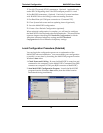
MultiVOIP User Guide Technical Configuration
59
Local Configuration Procedure (Summary)
After the MultiVOIP configuration software has been installed in the
‘Command’ PC (which is connected to the MultiVOIP unit), several
steps must be taken to configure the MultiVOIP to function in its
specific setting. Although the summary below includes all of these
steps, some are optional.
1. Check Power and Cabling.
2. Start MultiVOIP Configuration Program.
3. Confirm Connection.
4. Solve Common Connection Problems.
A. Fixing a COM Port Problem.
B. Fixing a Cabling Problem.
5. Familiarize yourself with configuration parameter screens and how
to access them.
6. Set Ethernet/IP Parameters.
7. Set up web browser GUI (optional).
8. Set Voice/Fax Parameters.
9. Set T1/E1 Parameters.
10. Set ISDN Parameters (if applicable).
11. Set Call Signaling parameters. The choice of H.323, SIP, or SPP is
made in the Outbound Phonebook, but details are configured in the
Call Signaling Parameters screen.
12. Set SNMP Parameters (applicable if MultiVoipManager remote
management software is used).
13. Set Regional Parameters (Phone Signaling Tones & Cadences and
setup for built-in Remote Configuration/Command Modem).
13. Set Custom Tones and Cadences (optional).
14. Set SMTP Parameters (applicable if Log Reports are via Email).
15. Set Log Reporting Method (GUI, locally in MultiVOIP
Configuration program; SNMP, remotely in MultiVoipManager
program; or SMTP, via email).
16. Set Supplementary Services Parameters. The Supplementary
Services screen allows voip deployment of features that are normally
found in PBX or PSTN systems (e.g., call transfer and call waiting).


















